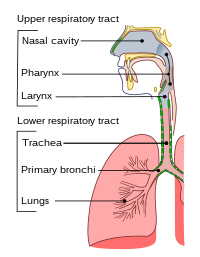
Photo from wikipedia
Background: In December 2019, in Wuhan, a new virus emerged, causing severe acute respiratory syndrome (SARS) secondary to infection by a type of coronavirus, causing coronavirus disease (COVID-19). The pandemic… Click to show full abstract
Background: In December 2019, in Wuhan, a new virus emerged, causing severe acute respiratory syndrome (SARS) secondary to infection by a type of coronavirus, causing coronavirus disease (COVID-19). The pandemic caused by the new coronavirus has had implications in the central nervous system. COVID-19 is known to be characterized by coagulation activation and endothelial dysfunction, causing ischemic and hemorrhagic vascular syndromes. Case Description: A 27-year-old male patient case with progressive decrease in visual acuity, associated with respiratory symptoms and intense headache. Multilobar infiltrate with a reticulonodular pattern is evident on chest CT scan. Brain CT scan with pituitary macroadenoma apoplexy was shown. SARS-Cov2 was confirmed, and respiratory support initiated. However, the patient died shortly afterward, secondary to pulmonary complications. Conclusion: The angiotensin-converting enzyme (ACE) II receptor is expressed in circumventricular organs and in cerebrovascular endothelial cells, which play a role in vascular autoregulation and cerebral blood flow. For this reason, is rational the hypothesize that brain ACE II could be involved in COVID-19 infection. Underlying mechanisms require further elucidation in the future.
Journal Title: Surgical Neurology International
Year Published: 2020
Link to full text (if available)
Share on Social Media: Sign Up to like & get
recommendations!